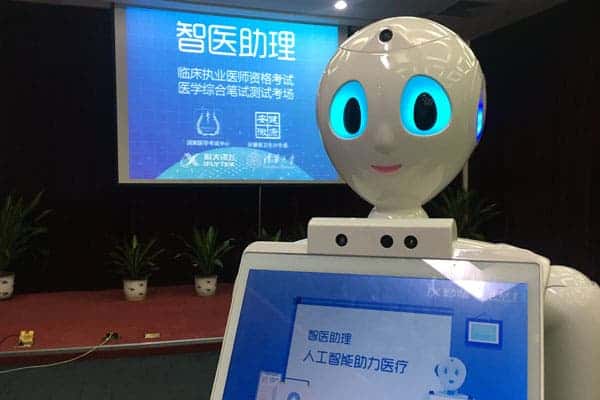A robot named Xiaoyi just passed the written stage of China’s national medical licensing examination, the first stepping stone for any would-be practitioner in the country. It’s the first time a robot has passed this or any comparable exam.

Image via China Daily.
The first time Xiaoyi (meaning Little Doctor) ever tried his hand at the exam, during a practice run, its results were less than stellar — barely scoring 100 out of the maximum 600. Since then, it’s pored over dozens of medical textbooks, more than 2 million medical records, and 400,000 articles in a bid to learn how to ‘doctor’. Xiaoyi took the real test in August and, according to the results released earlier this month, pulled off a stunning 456 points — 96 points above a passing grade.
Artificial medicine
It’s the first time an artificial intelligence passes this exam, and it did so in only a fraction of the allowed time, says iFlyTek, the company that developed the entity along with Tsinghua University.
Wu Ji, deputy director of Tsinghua’s electrical engineering department, says that their AI couldn’t learn the same way a human student does, for example. The read-memorize style of learning, or rote learning, wouldn’t cut it for a machine taking the test because “since 2013, more than half of the questions in the test are about [patient] cases,” Wu explained, “so it’s impossible to purely rely on memorizing and searches.”
Instead, they’ve instilled the robot with the ability to link words, sentences, even whole paragraphs together and give it a certain ability to reason. Xiaoyi’s developers worked with medical professionals while writing the robot’s code, drawing on their clinical and diagnostic expertise to tweak the robot’s algorithms.
This ability to interpret and to form connections between pieces of data, rather than merely storing and retrieving them, powered Xiaoyi’s impressive results on the digital version of the exam, which was overseen by the National Medical Examination Centre. Wu believes the machine’s score is a testament to its ability to learn, reason, and make judgments by itself. I’d take that with a grain of salt right now, however; we’ve programmed very smart machines, most exceeding the capability of a human’s in certain aspects before, and yes they do learn and form connections but in a very limited sense of the word.
Still, Xiaoyi is undeniably an amazing piece of technology, and it has made a spectacular debut with this result. It’s a ways off from working independently to diagnose people, Wu adds, but that doesn’t mean the AI won’t find its way to practitioners’ offices.
“Rather than replacing doctors, AI is able to help doctors better serve patients. By studying the medical cases and diagnosis skills of top doctors in top hospitals in megacities in China, our doctor AI can serve as an assistant to help doctors in remote areas in the country,” Wu said.
Xiaoyi can automatically capture and analyze patient information and help with initial diagnosis, and unlike other medical-inclined AIs out there, like IBM’s cancer-fighting Watson, the little doctor isn’t specialized in a single field. All very good news, especially so in China, a country that’s experiencing a significant shortage of medical personnel in rural areas.
“We will officially launch the robot in March 2018,” saif Liu Qingfeng, chairman of iFlytek. “It is not meant to replace doctors. Instead, it is to promote better people-machine cooperation so as to boost efficiency.”
On Wednesday, iFlyTek became a member of the AI alliance, set up by the Chinese Academy of Sciences, which aims to promote the research of basic sciences and the application of the cutting-edge technology. Its future plans include setting up a 1.02 billion yuan ($150 million USD) fund to support software and hardware developers, which will go towards startups that have core technologies but lack business know-how, or companies that excel in commercializing products but are unable to integrate AI into their devices.


